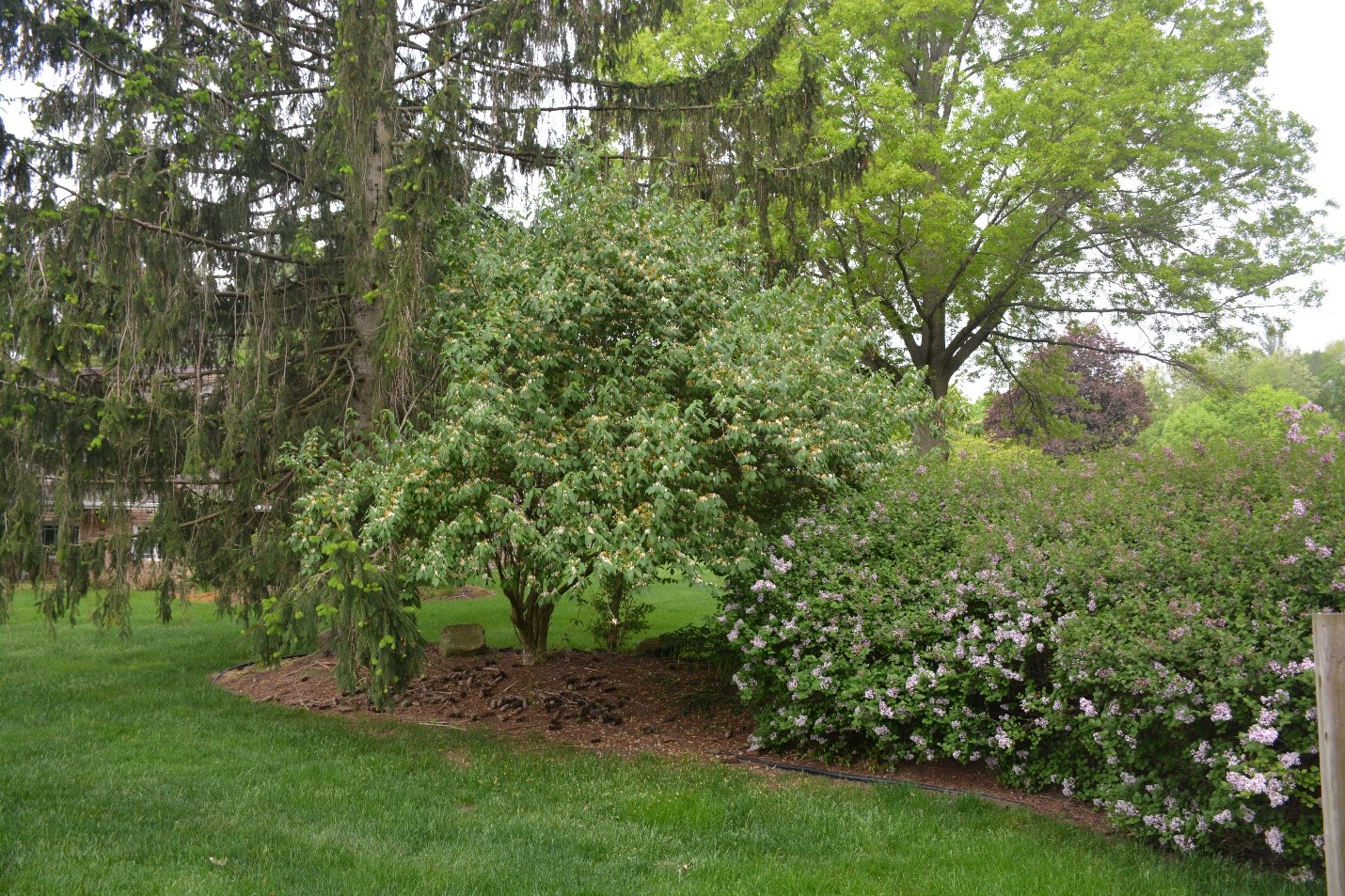Issue 2, May 19, 2023
Invasive Bush Honeysuckle in Bloom and Easily Noticed
Exotic bush honeysuckle is in bloom now in central Illinois. While the flowers are fragrant and lovely, this plant is invasive. In fact, it’s regulated by the Illinois Exotic Weed Act. While control is not required by law, removing this plant as soon as possible is advised given how easily it can spread and take over. It can be found in most counties and can tolerate a variety of conditions including wetness, dryness, sun, and shade.

Bush honeysuckle growing in a landscape bed, Travis Cleveland, University of Illinois.
Keep in mind that there are about 200 species of honeysuckle and many of which are well behaved ornamentals. In the 1800s, bush honeysuckle was grown as an ornamental in the Eastern U.S. But now it can be found way beyond the original plantings -- in forests edges, thickets, floodplains, roadsides, pastures and the like. Often it can still be found in urban backyards, frequently popping up and surprising gardeners. Invasive bush honeysuckles are often allowed to grow because landowners either don’t know the ecological problems associated with allowing them to grow or they simply can’t keep up with the arduous task of removing them.
While there are quite a few species of exotic bush honeysuckles, some of the more common ones in Illinois are Lonicera maackii (Amur honeysuckle), L. morrowii (Morrow's honeysuckle) and L. tatarica (Tartarian honeysuckle). They are native to Eurasia and grow as upright, deciduous shrubs (generally 6 to 15 ft.) that flower in the spring. Of course, there are native species too which can be easily confused. This is likely part of the problem as to why we see so much of it.
Bush honeysuckle plants commonly choke out native plants in forests. Some studies suggest they are allelopathic even. They have a competitive advantage in that they leaf out very early in the spring and then hold their leaves late into the fall. They can form a dense layer totally shading out native plants below it, ultimately reducing food and cover for wildlife. An abundance of berries are produced that serve as a source of seed for birds. However, as a result, the seeds are distributed widely. With bush honeysuckle, vegetative sprouting can also occur.

Bush honeysuckle growing within a Spirea bush, Travis Cleveland, University of Illinois.
Although, birds feed on the berries, please don’t think that exotic bush honeysuckle is good for birds. Research has shown that the fruit is less nutritious than that of native shrubs. In fact, I’ve heard these be referred to as “Skittles” for birds – a tasty snack but not the best primary food choice perhaps. Also, bird nests found in these plants result in less brood survival due to higher predation levels with nests being more visible by predators.
If you are unsure if you have a native or exotic honeysuckle in your landscape, check the stem. For exotics, the older stems are often hollow while most of our native bush honeysuckles have solid stems. In addition, berries and flower characteristics can also be used to differentiate among species. Another telling sign is the quickness of its spread. Exotic bush honeysuckle can overtake your landscape in only a year. Because exotic bush honeysuckles have leaves early and late in the season, they are particularly easy to spot during these times.
Bush honeysuckle leaves are egg-shaped and 1 to 2.5 inches long. Leaf tips can be rounded or distinctly pointed. But a key thing to look for is the arrangement. The leaves, flowers, and fruit are in pairs along the stem. The flowers vary from white, to yellow, to pink, to red depending upon the species. These develop into yellow, orange or red berries that contain several seeds.

Bush honeysuckle flowers, Travis Cleveland, University of Illinois.
Another Lonicera species that may be confused with bush honeysuckle is Japanese honeysuckle (L. japonica) which grows aggressively as a woody vine. Flowers are yellow and white in pairs, but the fruit is black. This plant is also invasive and should be removed.
Bush honeysuckle seedlings may be hand removed but it's advised that precautions are taken to not disturb the soil any more than necessary. This can lead to further seed germination. Because the root systems are often shallow, young plants can be pulled when soil is moist. A grubbing tool (even a simple shovel) can make this task easier. Plants can be cut back to the ground level. However, plan to cut them repeatedly as plants that are only cut once can form even denser stands.
Systemic herbicides such as glyphosate or triclopyr can be used as well. Depending on the product, applications can be made to the leaves, the bark or the cut stump. Please consider potential damage to surrounding sensitive plants when making control decisions. Remember to carefully read and follow all label directions. For specific information refer to: Management of Invasive Plants and Pests of Illinois.
Consider replacing this plant with a native honeysuckle such as Diervilla lonicera instead.
For more information about exotic bush honeysuckles, please visit:
Illinois Laws Regulating Noxious, Exotic Weeds – University of Illinois Extension
Invasive Plant Species – University of Illinois Extension
Bush Honeysuckle – IDNR
Author:
Michelle Wiesbrook